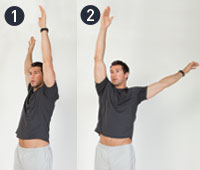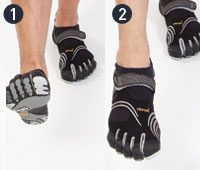
A few simple preventive strategies can prevent exercise-related injury and promote joint and muscle health.
A few simple preventive strategies can prevent exercise-related injury and promote joint and muscle health.
Exercise-related injuries are sneaky and can creep up without you ever knowing what happened. Listen to your joints when they speak to you. The subtle shoulder twinge, inflamed elbow, or grinding knee just might be your joints letting you know they aren’t very happy with your workouts.
Exercise is one of the very best ways to care for our body; however, if we are not mindful, our exercise program can end up being the culprit that causes those troublesome muscle aches and joint pains.
Somewhat strong and stable
Joints are always the weakest points in any skeleton. The bony structure of most of our joints is too shallow to play a significant role in stability, so that’s the job of the supporting ligaments and muscles.
Ligaments are the tough guys that hold bones together and prevent undesirable joint motion; however, ligaments aren’t exactly the most adaptable tissues. Like taffy they will stay stretched and will snap if stretched too far.
Ligament sprains are one of the most common exercise-related injuries, occurring often at the ankle and wrist when excessive stress on the joint stretches ligaments beyond their limit.
Healthy joint strategy
During your workouts avoid quick, jerking movements and excessive force that can drive a joint out of alignment.
Importance of muscle strength
The tone of the muscles whose tendons cross over joints is the most important factor for joint stability. Too much or too little tone can cause a problem of laxity or stiffness, both affecting joint function.
For example, the tendons of the quadriceps muscle cross over the knee joint. A weak and deconditioned quadriceps muscle means wobbly knees that won’t stand up to your workouts.
The poor flexibility of a tight hamstring muscle increases joint stiffness and reduces the knee’s shock absorption capability, which is especially important during impact activities such as running.
Healthy joint strategy
Cardio is not enough. If you have been hitting the gym but sticking to the elliptical, it is time to start your full-body stretch and strength training program. At least two full-body strength-training workouts per week will build and maintain a good strength base so all of your joints have healthy, strong muscles to support them.
An experienced instructor can help you design a balanced program that stretches the tight muscles and strengthens the weak ones.
Too much too soon
It is estimated that 10 percent of Canadians experienced a repetitive strain injury in the last 12 months. The swelling and inflammation of tendons, or tendinitis, is one of the most common issues among new exercisers or when a new activity is introduced.
Tendinitis can make joint movements extremely painful. You may have heard of golfer’s or tennis elbow, Achilles tendonitis, patellar tendonitis, and rotator cuff tendonitis. Tendinitis is considered an overuse injury that occurs when inadequate recovery and repair time is permitted after activity.
Healthy joint strategy
Always start small and progress gradually. The American College of Sports Medicine (2009) suggests that exercisers looking to increase their strength-training load add up to 10 percent for larger muscles and as low as 2 percent for smaller muscles.
When you can perform a strength-training exercise for one to two repetitions over the desired number of reps for two consecutive workouts, it is safe to add more weight.
Stressful repetition
The words “stress fracture” might imply a rather dramatic event; however, a stress fracture generally happens over time and is caused by low-intensity repetitive movements.
Repetitive physical forces without adequate rest in between are the primary offenders, overwhelming the ability of the skeletal system to repair fully. Frequent runners usually notice the onset of pain after an abrupt increase in duration or intensity of exercise.
Healthy joint strategy
Increase the level of repetitive impact exercises slowly. Gradually add distance or time to your run and allow adequate time for tissue repair between workouts.
Healthy joint moves
To deliver nourishment to the joints and power wash away waste, perform a sequence of gentle joint-specific movements every day, and especially before exercise.
Always perform a five- to 10-minute pre-exercise warmup such as walking or cycling to increase body temperature and lubricate the joints.
The following exercises are simple low-intensity movements that take the main joints of the body through their full range of motion. Move fully through each range of motion five to 10 times consecutively, with control, using only the force of your muscles.
(Fitness model Brendan Rolfe is a personal trainer and nutrition specialist at RAWE Health Solutions. rawehealth.com)
|
Stand with feet hip-width apart. Slowly bend the knees as if sitting down on a bench. Lower until the thighs are parallel to the ground while keeping the chest facing forward, then return to standing. |
|
Flex the wrist so the palm of the hand draws toward the inside of the wrist, and then extend the wrist so the back of the hand draws toward the top of the arm. |
|
Stand in neutral with both arms reaching straight up to the sky. Allow one arm to sweep down to the front of the body, past the hips, back behind the body, and then back to the starting position in a pendulum-like fashion. Alternate arms. |
04 Neck rotation

Gently rotate the head all the way to the left and then all the way to the right, moving in each direction as far as possible without using additional force.
05 Lateral neck flexion

Tilt the head to draw the left ear toward the left shoulder and then back to centre, and draw the right ear toward the right shoulder.
|
06 Neck flexion to extension Slowly lower the chin toward the chest; return to neutral, and slowly tilt the head backward so the eyes are gazing toward the sky. |
07 Hip swings

Stand in neutral with your left side next to a wall for balance support. Shift your weight onto the right leg, keeping the left leg straight; swing it forward and back through to extend behind the body. Repeat with other leg.

08 Spine lateral flexion Stand in neutral with the arms hanging naturally at the sides of the body. Bend sideways from the torso to the left, allowing the left arm to move down the left leg as far as possible without using additional force; move through centre and do the same on the right. |

09 Spine rotation Stand in neutral with the arms straight out to the side. Rotate the torso to the left and then right, moving in each direction as far as possible without using additional force. |
|
From a standing position, slowly and gently raise the heels from the ground, shifting the weight of the body onto the balls of the feet or tiptoes. Slowly lower until the feet are flat on the ground and then lean back onto the heels, allowing the toes to lift off the ground. |






























 01 Body weight squats
01 Body weight squats 02 Wrist flexion to extension
02 Wrist flexion to extension 03 Shoulder swings
03 Shoulder swings
 10 Ankle flexion to extension
10 Ankle flexion to extension




